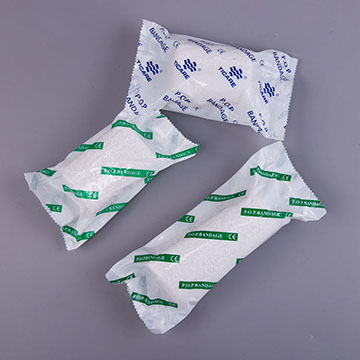Plaster of Paris bandages have been a staple in the medical field for many years, primarily used for creating casts that immobilize and support broken bones and other injuries. In this blog, we will explore what Plaster of Paris bandages are, how to use them, and how to safely remove them.
A Plaster of Paris bandage is a medical tool used to create a rigid and supportive cast around a fractured limb or joint. It is made by impregnating a gauze bandage with Plaster of Paris powder, which is a fine white powder made from gypsum. When the bandage is soaked in water, the Plaster of Paris reacts with the water to form a paste that hardens quickly as it dries, creating a solid and durable cast.

How to Use a Plaster of Paris Bandage
Using a Plaster of Paris bandage requires some preparation and care to ensure proper application and effectiveness. Here is a step-by-step guide:
-
Preparation:
-
Gather all necessary materials, including the Plaster of Paris bandage, a bucket or basin of warm water, protective gloves, and padding material (such as cotton rolls).
-
Ensure the area to be casted is clean and dry. Apply padding around the area to protect the skin and provide comfort.
-
Application:
-
Wear protective gloves to avoid skin irritation from the Plaster of Paris.
-
Submerge the Plaster of Paris bandage in warm water for a few seconds until it is fully saturated. Gently squeeze out excess water.
-
Starting at the end of the limb or joint, wrap the bandage snugly but not too tightly, overlapping each layer by about half the width of the bandage.
-
Continue wrapping until the entire area is covered, ensuring even coverage and thickness.
-
Smooth out any wrinkles or bubbles to create a uniform surface.
-
Setting:
-
Allow the cast to set and harden, which typically takes about 10-15 minutes. During this time, ensure the limb remains in the desired position.
-
Avoid moving the casted area until the plaster has fully hardened to prevent deformation.
-
Drying:
-
The cast will continue to dry and harden over the next 24-48 hours. Keep the cast dry and avoid getting it wet to maintain its integrity.
How to Remove a Plaster of Paris Bandage?
Removing a Plaster of Paris bandage should be done carefully to avoid injury. Follow these steps for safe removal:
-
Gather Tools:
-
Use appropriate tools such as a cast saw, scissors, and protective gloves.
-
Cutting the Cast:
-
Using a cast saw, carefully cut along the length of the cast. A cast saw is designed to vibrate rather than spin, reducing the risk of cutting the skin.
-
If a cast saw is not available, use scissors to cut the bandage, being extra cautious to avoid skin contact.
-
Spreading the Cast:
-
Once the cast is cut, gently spread the edges apart to release the limb. You may need to cut the padding underneath the plaster as well.
-
Removing the Cast:
-
Slowly and gently lift the cast off the limb. Avoid pulling or forcing the cast off to prevent injury.
-
Cleaning and Care:
-
Clean the skin thoroughly with mild soap and water to remove any residue.
-
Check for any signs of skin irritation or sores and apply appropriate care as needed.
Conclusion
Plaster of Paris bandages are a crucial tool in orthopedics, providing essential support and immobilization for healing fractures. Proper application and removal are key to ensuring their effectiveness and the patient's comfort and safety. Always seek professional medical advice and assistance when dealing with serious injuries and the use of medical bandages like Plaster of Paris.